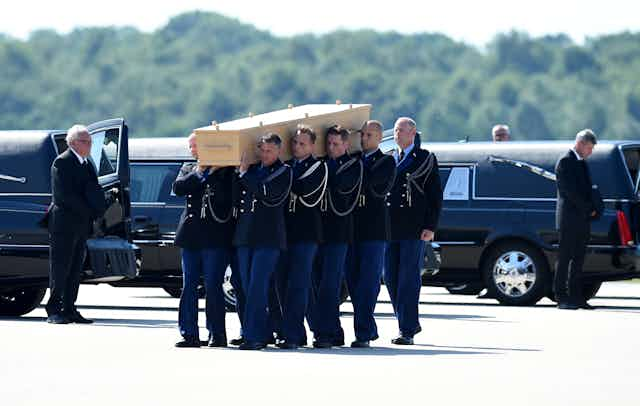The first of the bodies from Malaysian Airlines flight MH17 have arrived in the Netherlands ready for forensic investigation into the remains of the 298 passengers and crew.
Identifying the victims is going to pose many challenges given the potential state of the bodies and remains, both from the initial explosion and the delay in recovery, but dental records can definitely help.
It is not unusual for forensic science to investigate mass disasters and crimes, such as the 2001 World Trade Centre attacks in New York.
Neither is it unusual for forensic experts from different countries and organisations to participate into the one investigation, such as Nairobi’s Westgate mall attack in 2013.
But it is unusual when the incident occurs in a conflict region or area where there is no defined jurisdiction or hardly any legal structure to default to. This applies to the forensic investigation relating to the downing of the Malaysia Airlines Boeing 777 in eastern Ukraine.
There are legitimate questions relating to the jurisdiction – if any – in place, the security of the evidence and the safety of the expected forensic team of experts.

This is especially so when the militant groups who are accused of downing the aircraft and therefore creating the crime site will themselves be guarding the crime scene and the forensic experts expected to work at the scene!
As a proper forensic investigation has been so far deliberately or unintentionally delayed, concerns relating to the accurate identification of victims’ bodies become more confirmed.
As time passes, more crime site contamination is expected to occur along with the decomposition of victims’ bodies. The transfer of the first 40 bodies to the Netherlands is only now taking place after they were left in fields for several days of hot summer weather.
Overcoming time, temperature and contamination
Research in forensic medicine and forensic odontology can offer some reassuring news for families and friends of the victims.
Dental identification has always played a key role in natural and human-made disaster situations especially in identifying victims of fires, and victims of mass disasters and aviation disasters.
In cases where a body is charred, conventional autopsies and DNA profiling become problematic and very limited in certain situations. Bodies in these instances can be disfigured to such an extent that identification by a family member is neither reliable nor desirable.
But the teeth often remain a good source of identification in those situations.
Ongoing forensic research in Egypt has been evaluating the changes in the root density and morphology of the teeth subjected to extremely high temperatures equivalent to that resulting from aircraft’s explosion.
Digital dental radiography was used to investigate the possibility of using these changes to identify bodies exposed to extreme heat.

Research results confirmed that measuring the root density on direct digital radiographs and comparing the antemortem and postmortem values is a reliable tool for identification of bodies exposed at temperatures up to 1,100°C for durations up to 30 minutes.
Digital radiography is a preferred choice in any mass casualty situations where the number of victims overwhelms the ability of forensic examiners to quickly and accurately identify decedents. It’s also useful where other tools of identification may be restricted, problematic or time-consuming.
In the MH17 case, digital dental radiography can be employed for identification purposes as the teeth of the victims are not as vulnerable to contamination and immediate decomposition as other evidence and parts of the body are.
In addition, the creation of electronic teeth-radiographs can be easily networked and transferred between forensic scientists on site (eastern Ukraine and the Netherlands in this case) and their peer colleagues at laboratories wherever they are, including Australia, Malaysia and the UK.
These advancements in forensic science mean investigators may be able to contain much of the mess already done on the disaster scene.
Identifying the victims’ bodies and remains is not only a legal and moral requirement towards human dignity but also an impartial step for the families, friends and colleagues to help grieve their loss.
The unaccomplished mission
But the mission of forensic science is not only in identifying the victims’ bodies and remains. The major role of forensic science is to assist in achieving justice.

Forensics will play a critical role in crime reconstruction, providing scientific explanations to understand the sequence of events relating to the downing of the Malaysian aeroplane.
By doing so, forensic experts will assist in bringing offenders to trials.
Among all the political and military battles, this forensic battle seems very hard to win in a contested area with hardly any jurisdiction or legal framework in place.
Forensic science – first and foremost – is defined as “science pertaining to law”.
But in the MH17 case we have to wonder to which law will forensic science pertain? Will it be to the Russian law, Ukrainian law, the rebels’ rules and orders, international law or that at the Netherlands from where the MH17 departed but never landed or Malaysian law its intended destination?
This is a difficult question in a difficult region where political interest seems to override any other interest.
This article was co-authored with Dina Shokry, professor of forensic medicine and clinical toxicology at Cairo University and president of the New Mediterranian Academy of Forensic Science.

